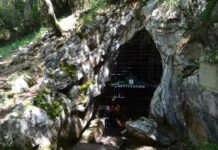This article was translated by John R. Bopp
The history of the arrival of non-Hispanic Europeans to the coasts of North America now has to be all rewritten, thanks to the discovery of an iron ax, which had been made in the Basque Country, in the archaeological excavations being carried out at the most important First People’s settlement in northeastern North America. This settlement was created by the Huron People, made up of dozens of communal houses surrounded by a defensive plaza and surrounded by huge corn fields, all in what is now today Whitchurch-Stouffville. Perhaps 2000 people lived there in the year 1500.
Until now, it was believed that the first encounter between Europeans and the Hurons who inhabited the Great Lakes region had been in 1615, when French explorer Étienne Brûlé reached Lake Ontario. The discovery of this iron Basque ax, therefore, radically changes the whole history of the first years of contact between the peoples of Europe and North America, pushing it forward at least 100 years. This is especially interesting if we remember that the ax was found about 1,500 km (900 mi) from where the Basques were whaling or building factories to pass the whaling season in the Gulf of St. Lawrence.


The archaeological discovery Ron Williamson and his colleagues has made is so important that, on July 6, a documentary, called “The Curse of the Axe”, will debut at the Royal Ontario Museum, and will then be aired to all of Canada on July 9.
Our question is, if there are almost 1,000 miles between the ritual burial site the ax was found in and the coast, and this ax was buried at the beginning of the 1500s, could that mean that there is now solid proof that the Basques where hunting whales in North American waters before Columbus arrived?
We can’t wait to watch the documentary.
Canada.com – 24/6/2012- Canada
Scrap of European iron unearths 500-year-old Canadian mystery
A Canadian archeologist who excavated the remains of a 500-year-old First Nations settlement near Toronto has revealed a stunning discovery: a carefully buried, European-made metal object that somehow reached the 16th-century Huron village nearly 100 years before the documented arrival of any white man in the Lake Ontario region. The unearthing of what appears to be part of a wrought-iron axe head at the so-called “Mantle” archeological site in present-day Whitchurch-Stouffville, Ont. — a fast-growing suburb about 40 kilometres east of Toronto — is showcased in a new documentary film, titled Curse of the Axe, to be screened for the first time Monday at the Royal Ontario Museum and broadcast nationwide July 9 on History Television.
(Follow) (Automatic translation)
————————-
Royal Ontario Museum -25/6/2012 – Canada
CURSE OF THE AXE: New Archaelogical Discoveries right under your feet!
The ROM is proud to present the world premiere screening of The Curse of the Axe. Narrated by Robbie Robertson of the legendary music groupThe Band, it is a riveting documentary of the recent extraordinary archaeological discovery right near Toronto that is rewriting history and our understanding of North American life before the arrival of the Europeans. Led by Dr. Ron Williamson, one of Canada’s foremost First Nations experts, a team of world-renowned archaeologists unearths the largest and most complex Huron First Nations village ever found and is stunned to discover that the village is 500 years old!
(Follow) (Automatic translation)
Last Updated on Dec 20, 2020 by About Basque Country































